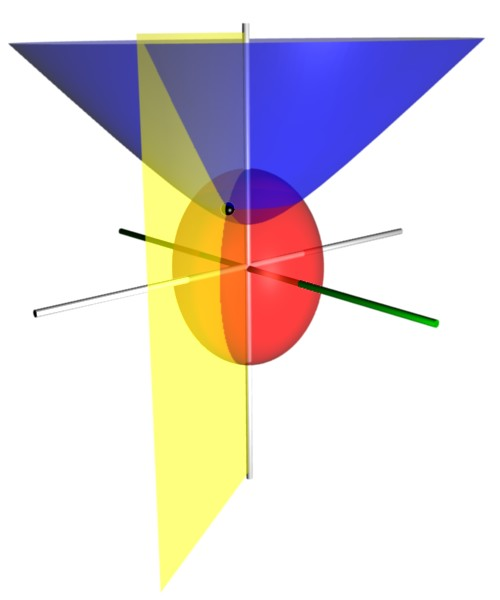
Prolate spheroidal coordinates are a three-dimensional
orthogonal
In mathematics, orthogonality is the generalization of the geometric notion of ''perpendicularity''.
By extension, orthogonality is also used to refer to the separation of specific features of a system. The term also has specialized meanings in ...
coordinate system
In geometry, a coordinate system is a system that uses one or more numbers, or coordinates, to uniquely determine the position of the points or other geometric elements on a manifold such as Euclidean space. The order of the coordinates is sig ...
that results from rotating the two-dimensional
elliptic coordinate system about the focal axis of the ellipse, i.e., the symmetry axis on which the foci are located. Rotation about the other axis produces
oblate spheroidal coordinates. Prolate spheroidal coordinates can also be considered as a
limiting case of
ellipsoidal coordinates in which the two smallest
principal axes are equal in length.
Prolate spheroidal coordinates can be used to solve various
partial differential equation
In mathematics, a partial differential equation (PDE) is an equation which imposes relations between the various partial derivatives of a multivariable function.
The function is often thought of as an "unknown" to be solved for, similarly to h ...
s in which the boundary conditions match its symmetry and shape, such as solving for a field produced by two centers, which are taken as the foci on the ''z''-axis. One example is solving for the
wavefunction
A wave function in quantum physics is a mathematical description of the quantum state of an isolated quantum system. The wave function is a complex-valued probability amplitude, and the probabilities for the possible results of measurements ma ...
of an
electron
The electron ( or ) is a subatomic particle with a negative one elementary electric charge. Electrons belong to the first generation of the lepton particle family,
and are generally thought to be elementary particles because they have no ...
moving in the
electromagnetic field
An electromagnetic field (also EM field or EMF) is a classical (i.e. non-quantum) field produced by (stationary or moving) electric charges. It is the field described by classical electrodynamics (a classical field theory) and is the classica ...
of two positively charged
nuclei, as in the
hydrogen molecular ion, H
2+. Another example is solving for the
electric field
An electric field (sometimes E-field) is the physical field that surrounds electrically charged particles and exerts force on all other charged particles in the field, either attracting or repelling them. It also refers to the physical field ...
generated by two small
electrode
An electrode is an electrical conductor used to make contact with a nonmetallic part of a circuit (e.g. a semiconductor, an electrolyte, a vacuum or air). Electrodes are essential parts of batteries that can consist of a variety of materials ...
tips. Other limiting cases include areas generated by a line segment (''μ'' = 0) or a line with a missing segment (ν=0). The electronic structure of general diatomic molecules with many electrons can also be solved to excellent precision in the prolate spheroidal coordinate system.
Definition

The most common definition of prolate spheroidal coordinates
is
:
:
:
where
is a nonnegative real number and
 Prolate spheroidal coordinates are a three-dimensional
Prolate spheroidal coordinates are a three-dimensional  The most common definition of prolate spheroidal coordinates is
:
:
:
where is a nonnegative real number and
The most common definition of prolate spheroidal coordinates is
:
:
:
where is a nonnegative real number and
 Prolate spheroidal coordinates are a three-dimensional
Prolate spheroidal coordinates are a three-dimensional  The most common definition of prolate spheroidal coordinates is
:
:
:
where is a nonnegative real number and
The most common definition of prolate spheroidal coordinates is
:
:
:
where is a nonnegative real number and